A coroner has ruled SAS soldiers were “justified” in the use of “lethal force” when they killed three Provisional IRA men in an SAS ambush during The Troubles in Northern Ireland.
But the coroner, Mr. Justice Michael Humphreys, heavily criticised the soldiers for destroying a video of the ambush and said senior British Army officers had taken steps to “excuse, justify, and support this reprehensible conduct.”
On June 3, 1991, Michael “Pete” Ryan, 37, Lawrence McNally, 39, and Tony Doris, 21, were gunned down in the village of Coagh in County Tyrone by a Special Military Unit comprising of SAS soldiers, which had set an ambush.
Their car collided with another vehicle and a wall and was engulfed in flames.
Doris was a cousin of Michelle O'Neill, the first minister of Northern Ireland, who is the vice president of Sinn Fein, which was at the time of the attack the political wing of the Provisional IRA (PIRA).
Police Investigation ‘Woefully Inadequate’
Delivering his preliminary findings on Thursday, Mr. Justice Humphreys said the Royal Ulster Constabulary’s original investigation of the Coagh incident had been “woefully inadequate.”He said, “If it was not for this inquest many of the facts would never have been known.”
Relatives of the victims have claimed the three men fell victim to a “shoot-to-kill” policy which the British Army was operating in Northern Ireland at the time and there was never any intention of arresting them.
Mr. Justice Humphreys addressed this at considerable length in his ruling.
He said he heard evidence the Special Branch had received intelligence that a PIRA unit was planning to kill a former member of the Ulster Defence Regiment (UDR) in a car park on the north side of the village of Coagh in late May or early June 1991.
The coroner said he heard evidence a “hard arrest” was planned with a “reaction group” in nearby Hanover Square tasked with the arrest.
But he said the strategy was “flawed” and “there was never any realistic prospect of the reaction group enacting an arrest.”

The coroner said, “The plan was conceived in a manner which meant the use of lethal force was highly likely, if not inevitable.”
Mr. Justice Humphreys said the police in 1991 had not asked any of the soldiers any questions about the planning for the ambush and he described this as an “obvious omission.”
He said George Christie, the detective superintendent who led the operation, gave evidence that certain questions of soldiers were “off limits.”
The coroner said soldiers who took part in the Coagh operation had deliberately destroyed a video which was taken of the incident.
Soldiers Showed ‘Willingness to Subvert the Rule of Law’
Mr. Justice Humphreys said, “The soldiers’ attitude showed a clear and unequivocal willingness to subvert the rule of law.”He then went on to criticise senior officers in the army who he said had taken every opportunity to, “excuse, justify, and support this reprehensible conduct.”
But on the crucial question of whether or not the killings of the three IRA men were lawful, the coroner ruled in favour of the soldiers. None of them were identified by name during the inquest.
He said there was evidence Soldier B shot dead Doris and Soldier G fired the fatal shots that killed both McNally and Ryan.
The coroner said in both cases he believed they held an “honest and genuine belief” that their lives or that of their comrades were in danger and he said their use of lethal force was “reasonable and proportionate.”
The inquest heard an SAS soldier posed as the former UDR soldier, and even dyed his hair to look like him.
As he approached the real target’s car in a car park on the banks of the Ballinderry river the PIRA gang drove over the bridge into the village in a red Vauxhall Cavalier.
Soldier H warned over the radio, “Red car, three up!”
The inquest heard the Cavalier pulled into the car park moments later and at least one of the gunmen got out and pointed a gun at Soldier L, who was posing as the target.
The commanding officer then gave the order, “Go, go, go” and the SAS team, who had been hiding in a flat-bed lorry, jumped out and aimed “suppressing fire” at the IRA gang.
Doris attempted to drive off but the soldiers continued firing at him and he crashed into a wall.
The coroner said he would not distinguish between Doris and the two other IRA men and he said there was no way the soldiers could have known that Doris was unarmed.
A former SAS man known only as Soldier F gave a statement to the inquest in 2022 in which he said he fired “aimed shots” believing his colleagues were in danger.
In the statement Soldier F said he had “struggled with ill health for some time” but had “done his best to assist in this inquest.”
SAS Veteran Jailed for Refusing to Testify
The former soldier, who lives in Scotland, was sentenced to six months in prison earlier this year for contempt of court for refusal to comply with a subpoena to give evidence.Soldier F’s testimony was the only element of the inquest which was outstanding and the coroner said on Thursday it was disappointing that Soldier F’s evidence could not be “tested under cross examination.”

The former serviceman is not connected to Soldier F, who is facing two counts of murder over the shooting of 13 civil rights protesters in Londonderry in 1972, an event better known as Bloody Sunday.
A former member of the IRA, Vincent McKenna, told an inquest hearing in June 2023, “All three men were active members of the ASU [active service unit], taking part in numerous attacks. I would describe them as being psychopaths as they seemed to have no conscience about killing.”
Coroner Took ‘Adverse’ View of Witness
In his ruling the coroner said he took an “adverse” view of McKenna and did not believe his evidence that McNally’s wife had taken him across the border into the Republic of Ireland shortly before the Coagh attack.The Troubles lasted between 1969 and 1998 and more than 3,600 people were killed as a result of attacks by the PIRA, other Irish republican groups, loyalist paramilitaries, and the actions of the security forces.







